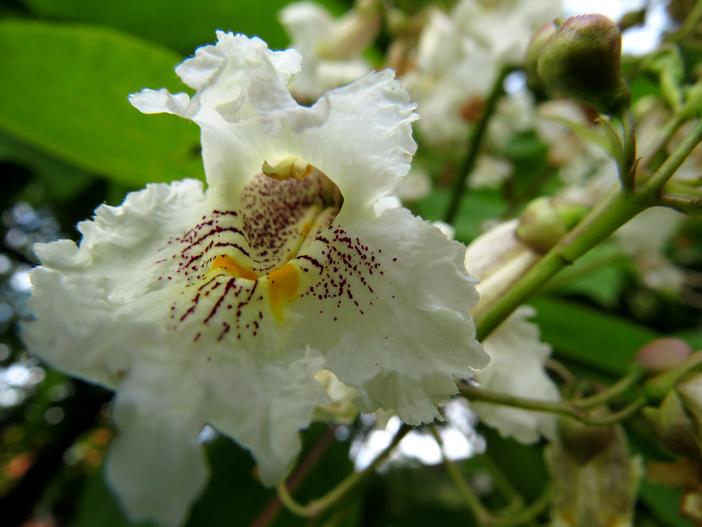Hybrid Catalpa
(Catalpa ×erubescens)
Hybrid Catalpa (Catalpa ×erubescens)
/
/

Blondinrikard Fröberg
CC BY 2.0
Image By:
Blondinrikard Fröberg
Recorded By:
Copyright:
CC BY 2.0
Copyright Notice:
Photo by: Blondinrikard Fröberg | License Type: CC BY 2.0 | License URL: https://creativecommons.org/licenses/by/2.0/ | Uploader: blondinrikard | Publisher: Flickr











Estimated Native Range
Summary
Catalpa ×erubescens, commonly known as hybrid catalpa, is a medium-sized deciduous tree resulting from the cross between Catalpa bignonioides native to the southeastern United States and Catalpa ovata from China. It typically reaches up to 65 feet in height and is known for its broad, irregular crown. The hybrid catalpa is notable for its large, heart-shaped leaves that emerge with a purplish tint before turning to a bright green as they mature. It produces showy clusters of white flowers with yellow and purple markings in late spring to early summer, followed by long, slender seed pods that persist into winter, adding to its ornamental value.
The hybrid catalpa is appreciated for its rapid growth rate, tolerance of urban pollution, and its ability to adapt to a range of soil conditions, though it prefers well-drained soils. It is often used in urban settings, as a shade tree in parks and gardens, and occasionally as a street tree. Full sun to partial shade is ideal for promoting its best growth and flowering. While generally easy to maintain, it can be susceptible to catalpa sphinx moth caterpillars, which can defoliate trees if present in large numbers. It has received the Royal Horticultural Society’s Award of Garden Merit, indicating its exceptional qualities for garden use.CC BY-SA 4.0
The hybrid catalpa is appreciated for its rapid growth rate, tolerance of urban pollution, and its ability to adapt to a range of soil conditions, though it prefers well-drained soils. It is often used in urban settings, as a shade tree in parks and gardens, and occasionally as a street tree. Full sun to partial shade is ideal for promoting its best growth and flowering. While generally easy to maintain, it can be susceptible to catalpa sphinx moth caterpillars, which can defoliate trees if present in large numbers. It has received the Royal Horticultural Society’s Award of Garden Merit, indicating its exceptional qualities for garden use.CC BY-SA 4.0
Plant Description
- Plant Type: Tree
- Height: 20-40 feet
- Width: 20-30 feet
- Growth Rate: Moderate
- Flower Color: White
- Flowering Season: Summer
- Leaf Retention: Deciduous
Growth Requirements
- Sun: Full Sun, Part Shade
- Water: Medium
- Drainage: Medium
Common Uses
Low Maintenance, Showy Flowers
Natural Habitat
A hybrid of species native to the southeastern United States and China
Other Names
Common Names: Erubescens Catalpa, Indian Bean Tree
Scientific Names: , Catalpa ×erubescens, Catalpa bignonioides f. erubescens, Catalpa bignonioides f. purpurea, Catalpa bignonioides var. purpurea, Catalpa ovata var. atropurpurea, Catalpa ovata var. purpurea, Catalpa syringifolia var. aureovittata, Catalpa syringifolia var. purpurea, Catalpa ×aureovittata
GBIF Accepted Name: